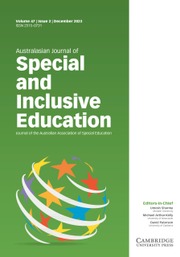No CrossRef data available.
Article contents
The Ins and Outs: How Principals Can Smooth Transitions Between School and Juvenile Justice Centres
Published online by Cambridge University Press: 08 October 2018
Abstract
Researchers note that the transitions of secondary students with disability in and out of the juvenile justice system are problematic for both the young person and leadership teams of their sending and receiving schools. Much of the literature focuses on barriers to successful transitions; however, there are some accounts of positive transition practices. In this article, we identify these positive practices and outline the steps school principals and executives involved in transitioning secondary school students with disability in and out of juvenile justice settings can take to smooth the way and improve student outcomes for this vulnerable population.
- Type
- Special Education Perspectives
- Information
- Australasian Journal of Special and Inclusive Education , Volume 42 , Issue 2 , December 2018 , pp. 158 - 170
- Copyright
- Copyright © The Author(s) 2018
Footnotes
* This manuscript was accepted under the Editorship of David Paterson.


